Accounting Principles: Context, Budgeting, Statements & Interpretation
VerifiedAdded on 2023/06/09
|17
|5188
|484
Report
AI Summary
This report provides a detailed analysis of accounting principles, starting with the role and scope of accounting in complex environments and its importance in decision-making. It covers key areas such as financial reporting, management reporting, and the advantages and disadvantages of accounting practices. The report delves into the primary branches of accounting, including management, taxation, and auditing, highlighting essential skills for accountants. It explains core accounting concepts like separate entity, ongoing concern, and matching principles, alongside discussions on regulation, compliance, and ethics. Furthermore, the report includes practical exercises such as preparing schedules for expected cash collections and disbursements, creating cash budgets, and constructing flexible budgets. The second part focuses on preparing an income statement and balance sheet, computing liquidity, profitability, and investment ratios, and providing an assessment of the organization's financial position with recommendations for improvement. The report concludes with key findings and suggestions based on the business's performance.
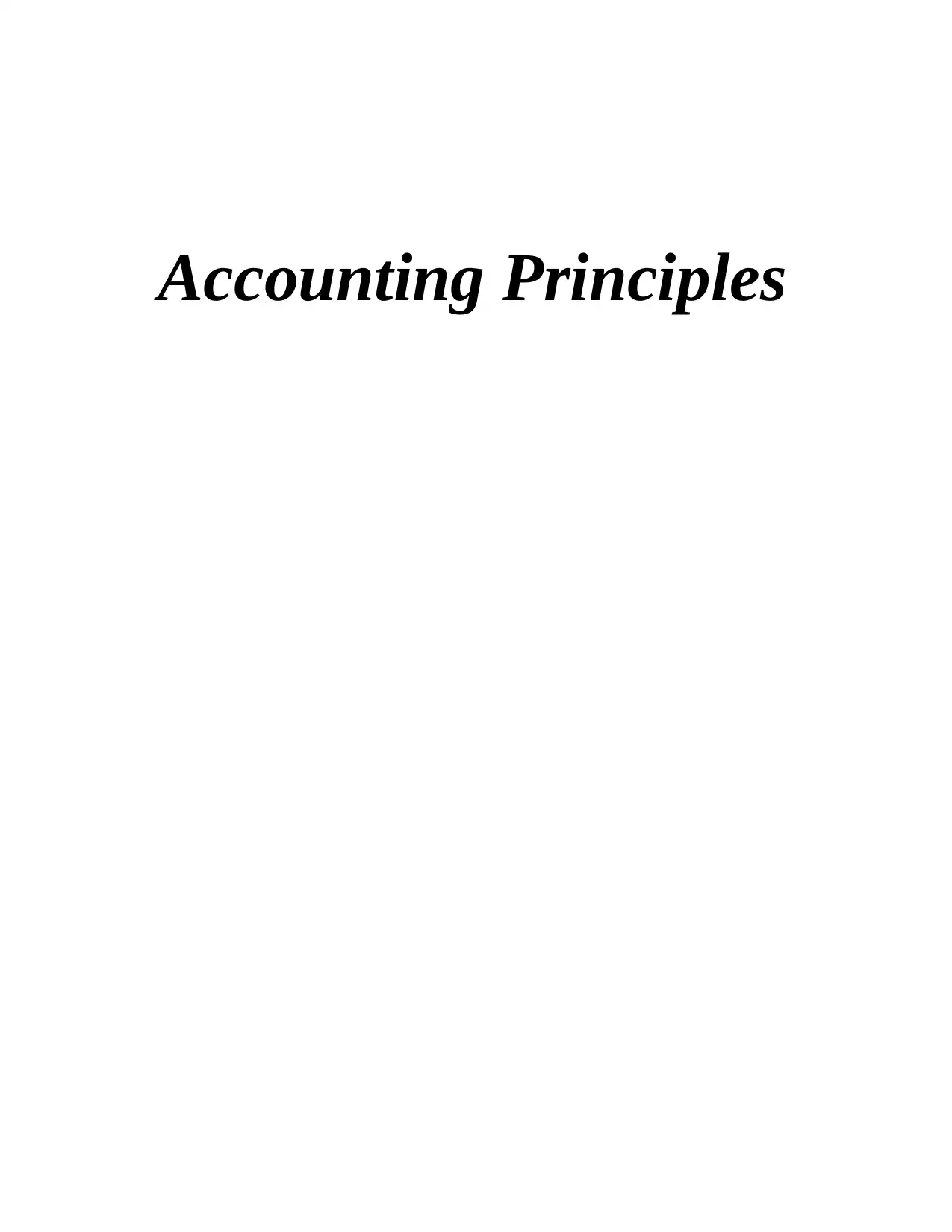
Accounting Principles
Paraphrase This Document
Need a fresh take? Get an instant paraphrase of this document with our AI Paraphraser
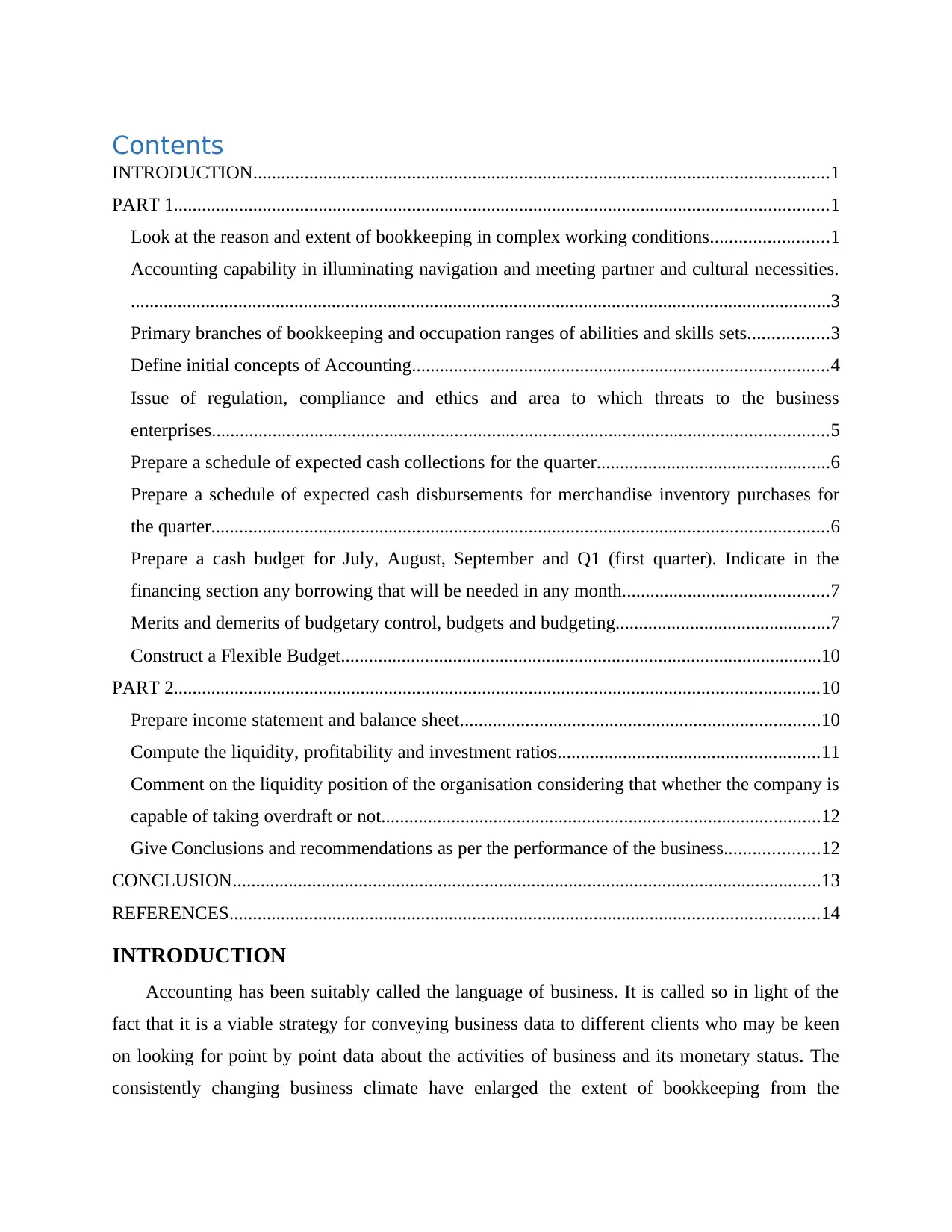
Contents
INTRODUCTION...........................................................................................................................1
PART 1............................................................................................................................................1
Look at the reason and extent of bookkeeping in complex working conditions.........................1
Accounting capability in illuminating navigation and meeting partner and cultural necessities.
......................................................................................................................................................3
Primary branches of bookkeeping and occupation ranges of abilities and skills sets.................3
Define initial concepts of Accounting.........................................................................................4
Issue of regulation, compliance and ethics and area to which threats to the business
enterprises....................................................................................................................................5
Prepare a schedule of expected cash collections for the quarter..................................................6
Prepare a schedule of expected cash disbursements for merchandise inventory purchases for
the quarter....................................................................................................................................6
Prepare a cash budget for July, August, September and Q1 (first quarter). Indicate in the
financing section any borrowing that will be needed in any month............................................7
Merits and demerits of budgetary control, budgets and budgeting..............................................7
Construct a Flexible Budget.......................................................................................................10
PART 2..........................................................................................................................................10
Prepare income statement and balance sheet.............................................................................10
Compute the liquidity, profitability and investment ratios........................................................11
Comment on the liquidity position of the organisation considering that whether the company is
capable of taking overdraft or not..............................................................................................12
Give Conclusions and recommendations as per the performance of the business....................12
CONCLUSION..............................................................................................................................13
REFERENCES..............................................................................................................................14
INTRODUCTION
Accounting has been suitably called the language of business. It is called so in light of the
fact that it is a viable strategy for conveying business data to different clients who may be keen
on looking for point by point data about the activities of business and its monetary status. The
consistently changing business climate have enlarged the extent of bookkeeping from the
INTRODUCTION...........................................................................................................................1
PART 1............................................................................................................................................1
Look at the reason and extent of bookkeeping in complex working conditions.........................1
Accounting capability in illuminating navigation and meeting partner and cultural necessities.
......................................................................................................................................................3
Primary branches of bookkeeping and occupation ranges of abilities and skills sets.................3
Define initial concepts of Accounting.........................................................................................4
Issue of regulation, compliance and ethics and area to which threats to the business
enterprises....................................................................................................................................5
Prepare a schedule of expected cash collections for the quarter..................................................6
Prepare a schedule of expected cash disbursements for merchandise inventory purchases for
the quarter....................................................................................................................................6
Prepare a cash budget for July, August, September and Q1 (first quarter). Indicate in the
financing section any borrowing that will be needed in any month............................................7
Merits and demerits of budgetary control, budgets and budgeting..............................................7
Construct a Flexible Budget.......................................................................................................10
PART 2..........................................................................................................................................10
Prepare income statement and balance sheet.............................................................................10
Compute the liquidity, profitability and investment ratios........................................................11
Comment on the liquidity position of the organisation considering that whether the company is
capable of taking overdraft or not..............................................................................................12
Give Conclusions and recommendations as per the performance of the business....................12
CONCLUSION..............................................................................................................................13
REFERENCES..............................................................................................................................14
INTRODUCTION
Accounting has been suitably called the language of business. It is called so in light of the
fact that it is a viable strategy for conveying business data to different clients who may be keen
on looking for point by point data about the activities of business and its monetary status. The
consistently changing business climate have enlarged the extent of bookkeeping from the
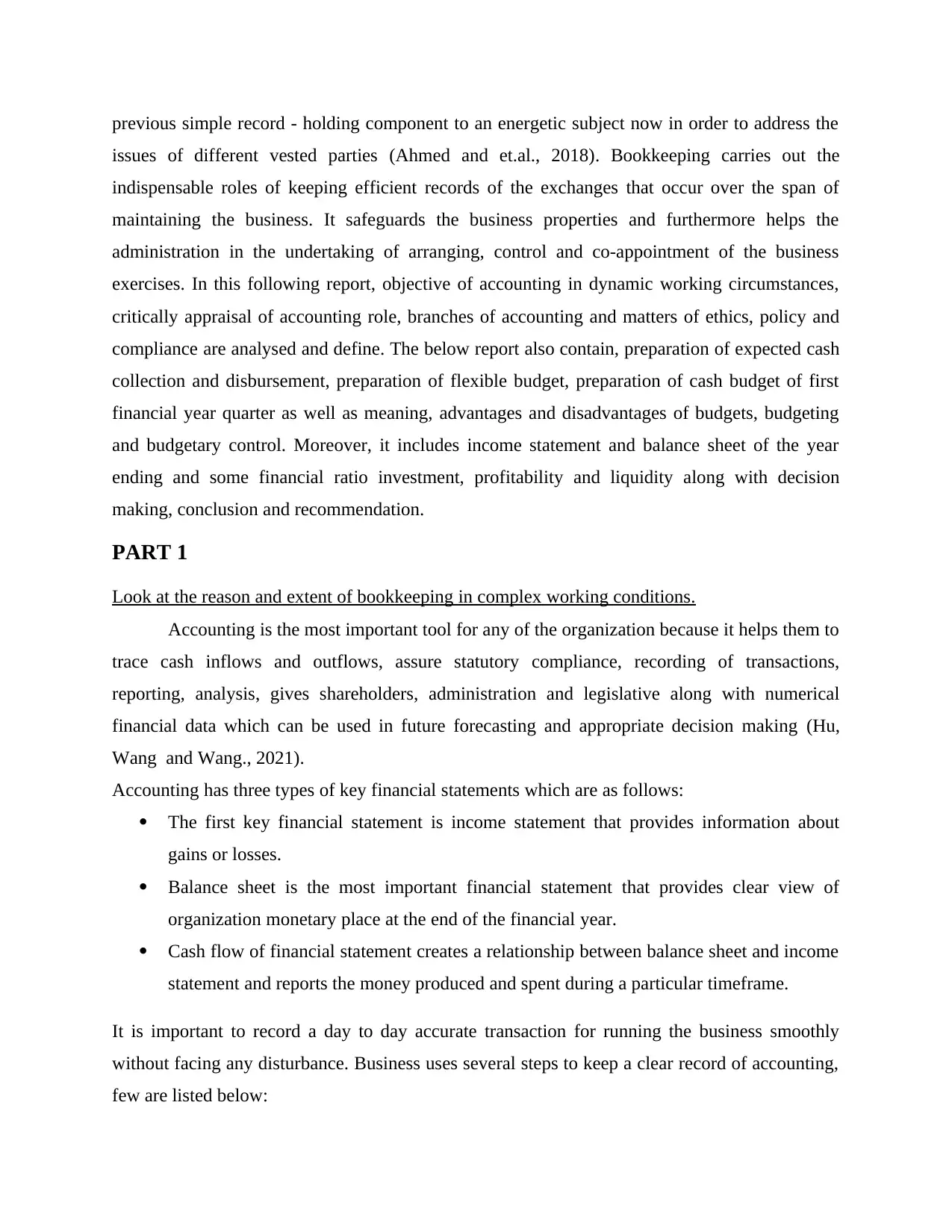
previous simple record - holding component to an energetic subject now in order to address the
issues of different vested parties (Ahmed and et.al., 2018). Bookkeeping carries out the
indispensable roles of keeping efficient records of the exchanges that occur over the span of
maintaining the business. It safeguards the business properties and furthermore helps the
administration in the undertaking of arranging, control and co-appointment of the business
exercises. In this following report, objective of accounting in dynamic working circumstances,
critically appraisal of accounting role, branches of accounting and matters of ethics, policy and
compliance are analysed and define. The below report also contain, preparation of expected cash
collection and disbursement, preparation of flexible budget, preparation of cash budget of first
financial year quarter as well as meaning, advantages and disadvantages of budgets, budgeting
and budgetary control. Moreover, it includes income statement and balance sheet of the year
ending and some financial ratio investment, profitability and liquidity along with decision
making, conclusion and recommendation.
PART 1
Look at the reason and extent of bookkeeping in complex working conditions.
Accounting is the most important tool for any of the organization because it helps them to
trace cash inflows and outflows, assure statutory compliance, recording of transactions,
reporting, analysis, gives shareholders, administration and legislative along with numerical
financial data which can be used in future forecasting and appropriate decision making (Hu,
Wang and Wang., 2021).
Accounting has three types of key financial statements which are as follows:
The first key financial statement is income statement that provides information about
gains or losses.
Balance sheet is the most important financial statement that provides clear view of
organization monetary place at the end of the financial year.
Cash flow of financial statement creates a relationship between balance sheet and income
statement and reports the money produced and spent during a particular timeframe.
It is important to record a day to day accurate transaction for running the business smoothly
without facing any disturbance. Business uses several steps to keep a clear record of accounting,
few are listed below:
issues of different vested parties (Ahmed and et.al., 2018). Bookkeeping carries out the
indispensable roles of keeping efficient records of the exchanges that occur over the span of
maintaining the business. It safeguards the business properties and furthermore helps the
administration in the undertaking of arranging, control and co-appointment of the business
exercises. In this following report, objective of accounting in dynamic working circumstances,
critically appraisal of accounting role, branches of accounting and matters of ethics, policy and
compliance are analysed and define. The below report also contain, preparation of expected cash
collection and disbursement, preparation of flexible budget, preparation of cash budget of first
financial year quarter as well as meaning, advantages and disadvantages of budgets, budgeting
and budgetary control. Moreover, it includes income statement and balance sheet of the year
ending and some financial ratio investment, profitability and liquidity along with decision
making, conclusion and recommendation.
PART 1
Look at the reason and extent of bookkeeping in complex working conditions.
Accounting is the most important tool for any of the organization because it helps them to
trace cash inflows and outflows, assure statutory compliance, recording of transactions,
reporting, analysis, gives shareholders, administration and legislative along with numerical
financial data which can be used in future forecasting and appropriate decision making (Hu,
Wang and Wang., 2021).
Accounting has three types of key financial statements which are as follows:
The first key financial statement is income statement that provides information about
gains or losses.
Balance sheet is the most important financial statement that provides clear view of
organization monetary place at the end of the financial year.
Cash flow of financial statement creates a relationship between balance sheet and income
statement and reports the money produced and spent during a particular timeframe.
It is important to record a day to day accurate transaction for running the business smoothly
without facing any disturbance. Business uses several steps to keep a clear record of accounting,
few are listed below:
⊘ This is a preview!⊘
Do you want full access?
Subscribe today to unlock all pages.

Trusted by 1+ million students worldwide
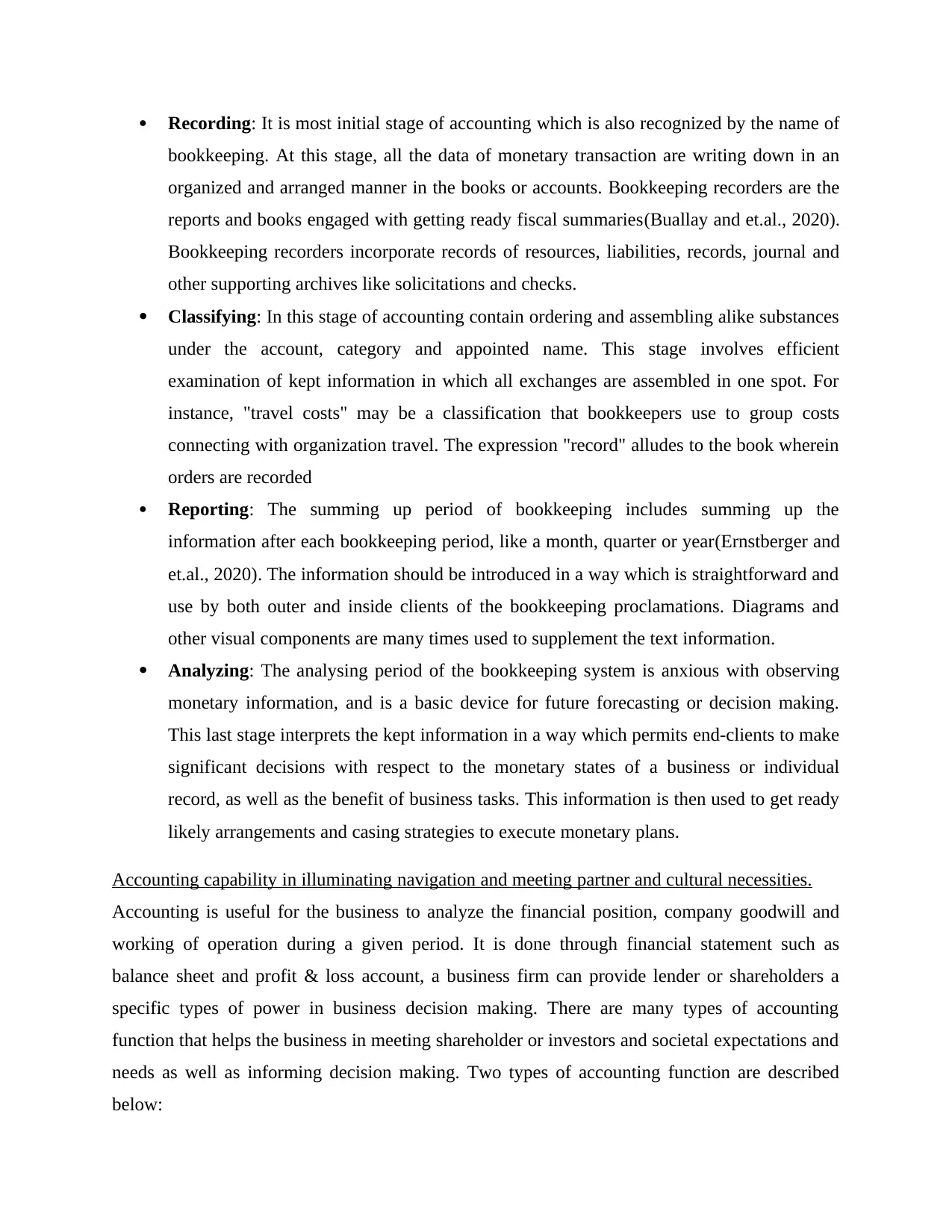
Recording: It is most initial stage of accounting which is also recognized by the name of
bookkeeping. At this stage, all the data of monetary transaction are writing down in an
organized and arranged manner in the books or accounts. Bookkeeping recorders are the
reports and books engaged with getting ready fiscal summaries(Buallay and et.al., 2020).
Bookkeeping recorders incorporate records of resources, liabilities, records, journal and
other supporting archives like solicitations and checks.
Classifying: In this stage of accounting contain ordering and assembling alike substances
under the account, category and appointed name. This stage involves efficient
examination of kept information in which all exchanges are assembled in one spot. For
instance, "travel costs" may be a classification that bookkeepers use to group costs
connecting with organization travel. The expression "record" alludes to the book wherein
orders are recorded
Reporting: The summing up period of bookkeeping includes summing up the
information after each bookkeeping period, like a month, quarter or year(Ernstberger and
et.al., 2020). The information should be introduced in a way which is straightforward and
use by both outer and inside clients of the bookkeeping proclamations. Diagrams and
other visual components are many times used to supplement the text information.
Analyzing: The analysing period of the bookkeeping system is anxious with observing
monetary information, and is a basic device for future forecasting or decision making.
This last stage interprets the kept information in a way which permits end-clients to make
significant decisions with respect to the monetary states of a business or individual
record, as well as the benefit of business tasks. This information is then used to get ready
likely arrangements and casing strategies to execute monetary plans.
Accounting capability in illuminating navigation and meeting partner and cultural necessities.
Accounting is useful for the business to analyze the financial position, company goodwill and
working of operation during a given period. It is done through financial statement such as
balance sheet and profit & loss account, a business firm can provide lender or shareholders a
specific types of power in business decision making. There are many types of accounting
function that helps the business in meeting shareholder or investors and societal expectations and
needs as well as informing decision making. Two types of accounting function are described
below:
bookkeeping. At this stage, all the data of monetary transaction are writing down in an
organized and arranged manner in the books or accounts. Bookkeeping recorders are the
reports and books engaged with getting ready fiscal summaries(Buallay and et.al., 2020).
Bookkeeping recorders incorporate records of resources, liabilities, records, journal and
other supporting archives like solicitations and checks.
Classifying: In this stage of accounting contain ordering and assembling alike substances
under the account, category and appointed name. This stage involves efficient
examination of kept information in which all exchanges are assembled in one spot. For
instance, "travel costs" may be a classification that bookkeepers use to group costs
connecting with organization travel. The expression "record" alludes to the book wherein
orders are recorded
Reporting: The summing up period of bookkeeping includes summing up the
information after each bookkeeping period, like a month, quarter or year(Ernstberger and
et.al., 2020). The information should be introduced in a way which is straightforward and
use by both outer and inside clients of the bookkeeping proclamations. Diagrams and
other visual components are many times used to supplement the text information.
Analyzing: The analysing period of the bookkeeping system is anxious with observing
monetary information, and is a basic device for future forecasting or decision making.
This last stage interprets the kept information in a way which permits end-clients to make
significant decisions with respect to the monetary states of a business or individual
record, as well as the benefit of business tasks. This information is then used to get ready
likely arrangements and casing strategies to execute monetary plans.
Accounting capability in illuminating navigation and meeting partner and cultural necessities.
Accounting is useful for the business to analyze the financial position, company goodwill and
working of operation during a given period. It is done through financial statement such as
balance sheet and profit & loss account, a business firm can provide lender or shareholders a
specific types of power in business decision making. There are many types of accounting
function that helps the business in meeting shareholder or investors and societal expectations and
needs as well as informing decision making. Two types of accounting function are described
below:
Paraphrase This Document
Need a fresh take? Get an instant paraphrase of this document with our AI Paraphraser
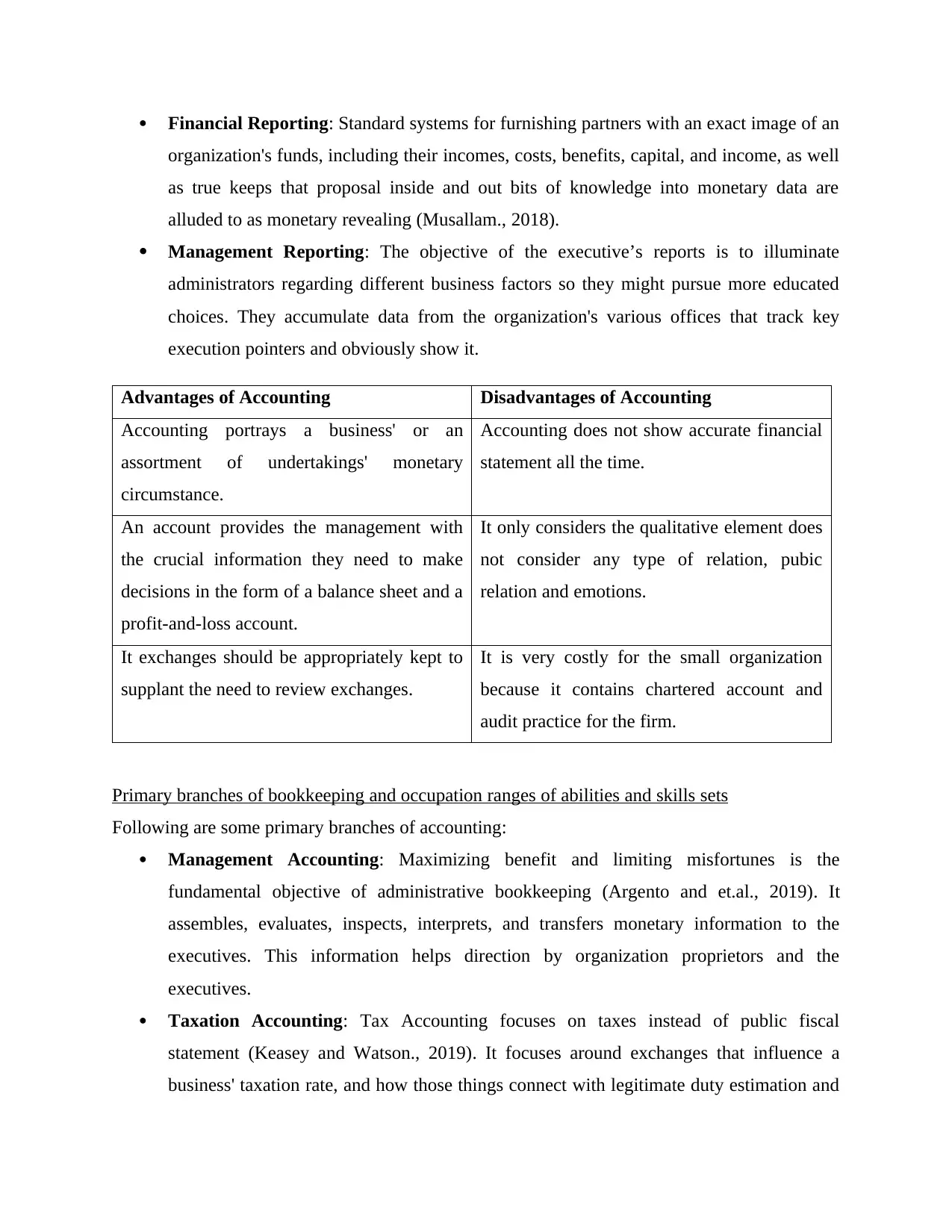
Financial Reporting: Standard systems for furnishing partners with an exact image of an
organization's funds, including their incomes, costs, benefits, capital, and income, as well
as true keeps that proposal inside and out bits of knowledge into monetary data are
alluded to as monetary revealing (Musallam., 2018).
Management Reporting: The objective of the executive’s reports is to illuminate
administrators regarding different business factors so they might pursue more educated
choices. They accumulate data from the organization's various offices that track key
execution pointers and obviously show it.
Advantages of Accounting Disadvantages of Accounting
Accounting portrays a business' or an
assortment of undertakings' monetary
circumstance.
Accounting does not show accurate financial
statement all the time.
An account provides the management with
the crucial information they need to make
decisions in the form of a balance sheet and a
profit-and-loss account.
It only considers the qualitative element does
not consider any type of relation, pubic
relation and emotions.
It exchanges should be appropriately kept to
supplant the need to review exchanges.
It is very costly for the small organization
because it contains chartered account and
audit practice for the firm.
Primary branches of bookkeeping and occupation ranges of abilities and skills sets
Following are some primary branches of accounting:
Management Accounting: Maximizing benefit and limiting misfortunes is the
fundamental objective of administrative bookkeeping (Argento and et.al., 2019). It
assembles, evaluates, inspects, interprets, and transfers monetary information to the
executives. This information helps direction by organization proprietors and the
executives.
Taxation Accounting: Tax Accounting focuses on taxes instead of public fiscal
statement (Keasey and Watson., 2019). It focuses around exchanges that influence a
business' taxation rate, and how those things connect with legitimate duty estimation and
organization's funds, including their incomes, costs, benefits, capital, and income, as well
as true keeps that proposal inside and out bits of knowledge into monetary data are
alluded to as monetary revealing (Musallam., 2018).
Management Reporting: The objective of the executive’s reports is to illuminate
administrators regarding different business factors so they might pursue more educated
choices. They accumulate data from the organization's various offices that track key
execution pointers and obviously show it.
Advantages of Accounting Disadvantages of Accounting
Accounting portrays a business' or an
assortment of undertakings' monetary
circumstance.
Accounting does not show accurate financial
statement all the time.
An account provides the management with
the crucial information they need to make
decisions in the form of a balance sheet and a
profit-and-loss account.
It only considers the qualitative element does
not consider any type of relation, pubic
relation and emotions.
It exchanges should be appropriately kept to
supplant the need to review exchanges.
It is very costly for the small organization
because it contains chartered account and
audit practice for the firm.
Primary branches of bookkeeping and occupation ranges of abilities and skills sets
Following are some primary branches of accounting:
Management Accounting: Maximizing benefit and limiting misfortunes is the
fundamental objective of administrative bookkeeping (Argento and et.al., 2019). It
assembles, evaluates, inspects, interprets, and transfers monetary information to the
executives. This information helps direction by organization proprietors and the
executives.
Taxation Accounting: Tax Accounting focuses on taxes instead of public fiscal
statement (Keasey and Watson., 2019). It focuses around exchanges that influence a
business' taxation rate, and how those things connect with legitimate duty estimation and
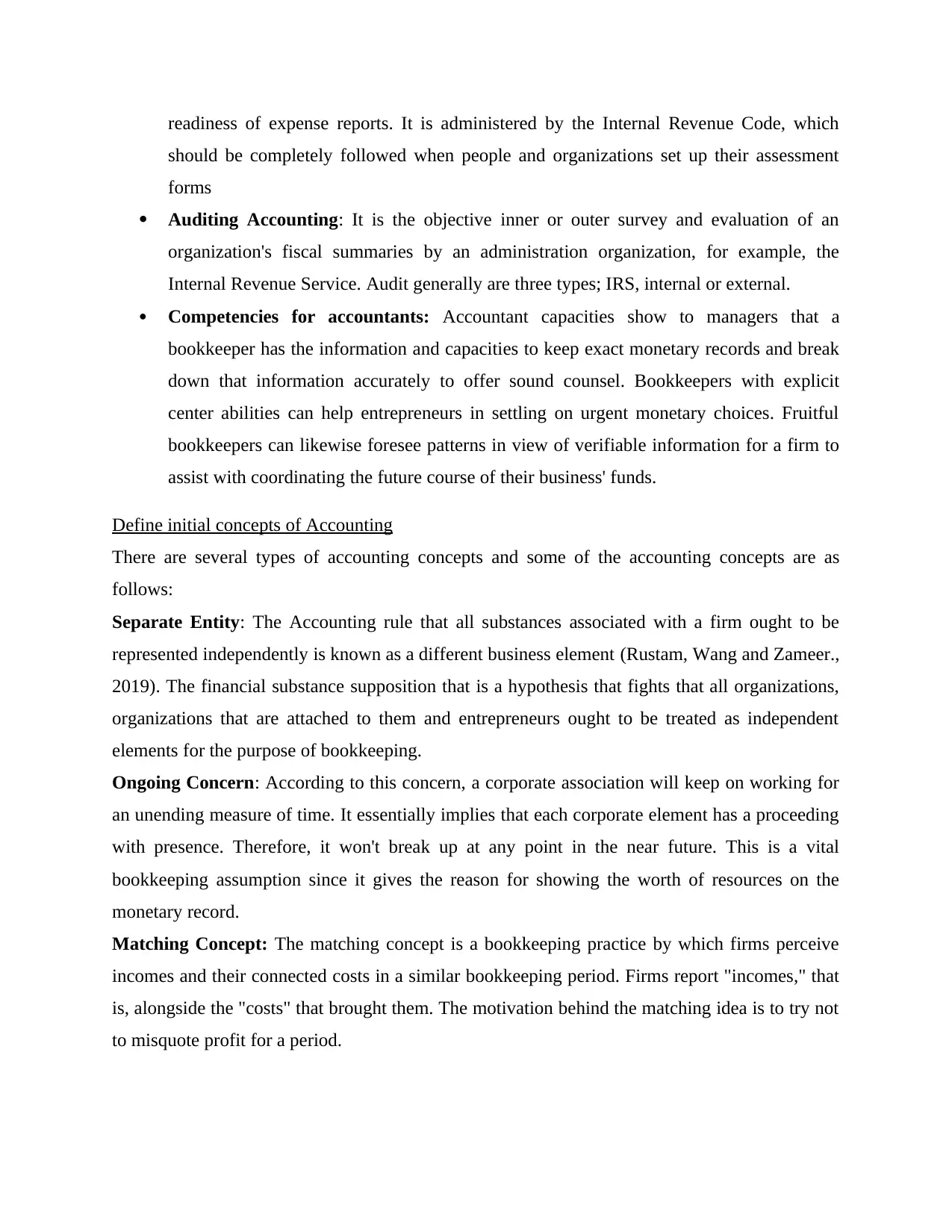
readiness of expense reports. It is administered by the Internal Revenue Code, which
should be completely followed when people and organizations set up their assessment
forms
Auditing Accounting: It is the objective inner or outer survey and evaluation of an
organization's fiscal summaries by an administration organization, for example, the
Internal Revenue Service. Audit generally are three types; IRS, internal or external.
Competencies for accountants: Accountant capacities show to managers that a
bookkeeper has the information and capacities to keep exact monetary records and break
down that information accurately to offer sound counsel. Bookkeepers with explicit
center abilities can help entrepreneurs in settling on urgent monetary choices. Fruitful
bookkeepers can likewise foresee patterns in view of verifiable information for a firm to
assist with coordinating the future course of their business' funds.
Define initial concepts of Accounting
There are several types of accounting concepts and some of the accounting concepts are as
follows:
Separate Entity: The Accounting rule that all substances associated with a firm ought to be
represented independently is known as a different business element (Rustam, Wang and Zameer.,
2019). The financial substance supposition that is a hypothesis that fights that all organizations,
organizations that are attached to them and entrepreneurs ought to be treated as independent
elements for the purpose of bookkeeping.
Ongoing Concern: According to this concern, a corporate association will keep on working for
an unending measure of time. It essentially implies that each corporate element has a proceeding
with presence. Therefore, it won't break up at any point in the near future. This is a vital
bookkeeping assumption since it gives the reason for showing the worth of resources on the
monetary record.
Matching Concept: The matching concept is a bookkeeping practice by which firms perceive
incomes and their connected costs in a similar bookkeeping period. Firms report "incomes," that
is, alongside the "costs" that brought them. The motivation behind the matching idea is to try not
to misquote profit for a period.
should be completely followed when people and organizations set up their assessment
forms
Auditing Accounting: It is the objective inner or outer survey and evaluation of an
organization's fiscal summaries by an administration organization, for example, the
Internal Revenue Service. Audit generally are three types; IRS, internal or external.
Competencies for accountants: Accountant capacities show to managers that a
bookkeeper has the information and capacities to keep exact monetary records and break
down that information accurately to offer sound counsel. Bookkeepers with explicit
center abilities can help entrepreneurs in settling on urgent monetary choices. Fruitful
bookkeepers can likewise foresee patterns in view of verifiable information for a firm to
assist with coordinating the future course of their business' funds.
Define initial concepts of Accounting
There are several types of accounting concepts and some of the accounting concepts are as
follows:
Separate Entity: The Accounting rule that all substances associated with a firm ought to be
represented independently is known as a different business element (Rustam, Wang and Zameer.,
2019). The financial substance supposition that is a hypothesis that fights that all organizations,
organizations that are attached to them and entrepreneurs ought to be treated as independent
elements for the purpose of bookkeeping.
Ongoing Concern: According to this concern, a corporate association will keep on working for
an unending measure of time. It essentially implies that each corporate element has a proceeding
with presence. Therefore, it won't break up at any point in the near future. This is a vital
bookkeeping assumption since it gives the reason for showing the worth of resources on the
monetary record.
Matching Concept: The matching concept is a bookkeeping practice by which firms perceive
incomes and their connected costs in a similar bookkeeping period. Firms report "incomes," that
is, alongside the "costs" that brought them. The motivation behind the matching idea is to try not
to misquote profit for a period.
⊘ This is a preview!⊘
Do you want full access?
Subscribe today to unlock all pages.

Trusted by 1+ million students worldwide
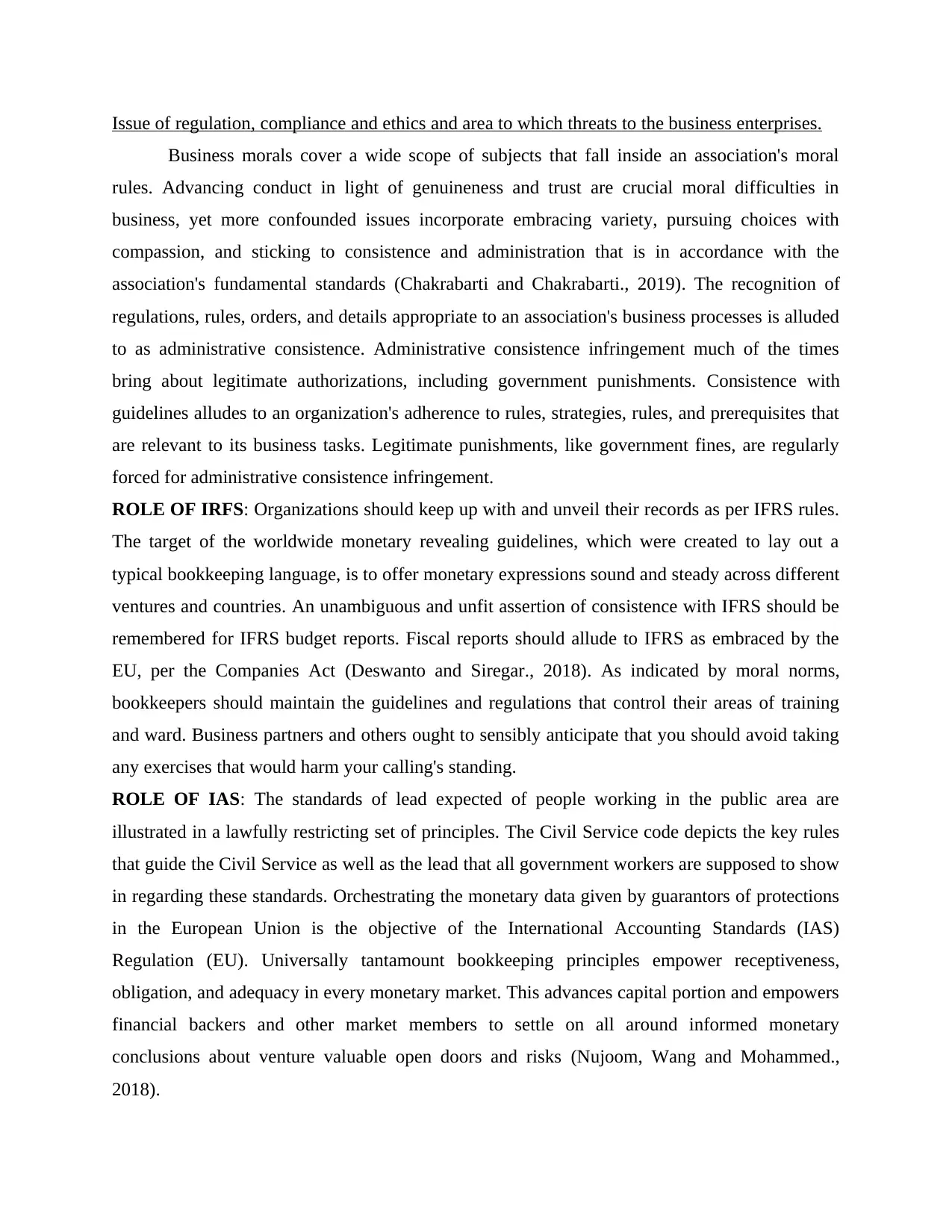
Issue of regulation, compliance and ethics and area to which threats to the business enterprises.
Business morals cover a wide scope of subjects that fall inside an association's moral
rules. Advancing conduct in light of genuineness and trust are crucial moral difficulties in
business, yet more confounded issues incorporate embracing variety, pursuing choices with
compassion, and sticking to consistence and administration that is in accordance with the
association's fundamental standards (Chakrabarti and Chakrabarti., 2019). The recognition of
regulations, rules, orders, and details appropriate to an association's business processes is alluded
to as administrative consistence. Administrative consistence infringement much of the times
bring about legitimate authorizations, including government punishments. Consistence with
guidelines alludes to an organization's adherence to rules, strategies, rules, and prerequisites that
are relevant to its business tasks. Legitimate punishments, like government fines, are regularly
forced for administrative consistence infringement.
ROLE OF IRFS: Organizations should keep up with and unveil their records as per IFRS rules.
The target of the worldwide monetary revealing guidelines, which were created to lay out a
typical bookkeeping language, is to offer monetary expressions sound and steady across different
ventures and countries. An unambiguous and unfit assertion of consistence with IFRS should be
remembered for IFRS budget reports. Fiscal reports should allude to IFRS as embraced by the
EU, per the Companies Act (Deswanto and Siregar., 2018). As indicated by moral norms,
bookkeepers should maintain the guidelines and regulations that control their areas of training
and ward. Business partners and others ought to sensibly anticipate that you should avoid taking
any exercises that would harm your calling's standing.
ROLE OF IAS: The standards of lead expected of people working in the public area are
illustrated in a lawfully restricting set of principles. The Civil Service code depicts the key rules
that guide the Civil Service as well as the lead that all government workers are supposed to show
in regarding these standards. Orchestrating the monetary data given by guarantors of protections
in the European Union is the objective of the International Accounting Standards (IAS)
Regulation (EU). Universally tantamount bookkeeping principles empower receptiveness,
obligation, and adequacy in every monetary market. This advances capital portion and empowers
financial backers and other market members to settle on all around informed monetary
conclusions about venture valuable open doors and risks (Nujoom, Wang and Mohammed.,
2018).
Business morals cover a wide scope of subjects that fall inside an association's moral
rules. Advancing conduct in light of genuineness and trust are crucial moral difficulties in
business, yet more confounded issues incorporate embracing variety, pursuing choices with
compassion, and sticking to consistence and administration that is in accordance with the
association's fundamental standards (Chakrabarti and Chakrabarti., 2019). The recognition of
regulations, rules, orders, and details appropriate to an association's business processes is alluded
to as administrative consistence. Administrative consistence infringement much of the times
bring about legitimate authorizations, including government punishments. Consistence with
guidelines alludes to an organization's adherence to rules, strategies, rules, and prerequisites that
are relevant to its business tasks. Legitimate punishments, like government fines, are regularly
forced for administrative consistence infringement.
ROLE OF IRFS: Organizations should keep up with and unveil their records as per IFRS rules.
The target of the worldwide monetary revealing guidelines, which were created to lay out a
typical bookkeeping language, is to offer monetary expressions sound and steady across different
ventures and countries. An unambiguous and unfit assertion of consistence with IFRS should be
remembered for IFRS budget reports. Fiscal reports should allude to IFRS as embraced by the
EU, per the Companies Act (Deswanto and Siregar., 2018). As indicated by moral norms,
bookkeepers should maintain the guidelines and regulations that control their areas of training
and ward. Business partners and others ought to sensibly anticipate that you should avoid taking
any exercises that would harm your calling's standing.
ROLE OF IAS: The standards of lead expected of people working in the public area are
illustrated in a lawfully restricting set of principles. The Civil Service code depicts the key rules
that guide the Civil Service as well as the lead that all government workers are supposed to show
in regarding these standards. Orchestrating the monetary data given by guarantors of protections
in the European Union is the objective of the International Accounting Standards (IAS)
Regulation (EU). Universally tantamount bookkeeping principles empower receptiveness,
obligation, and adequacy in every monetary market. This advances capital portion and empowers
financial backers and other market members to settle on all around informed monetary
conclusions about venture valuable open doors and risks (Nujoom, Wang and Mohammed.,
2018).
Paraphrase This Document
Need a fresh take? Get an instant paraphrase of this document with our AI Paraphraser
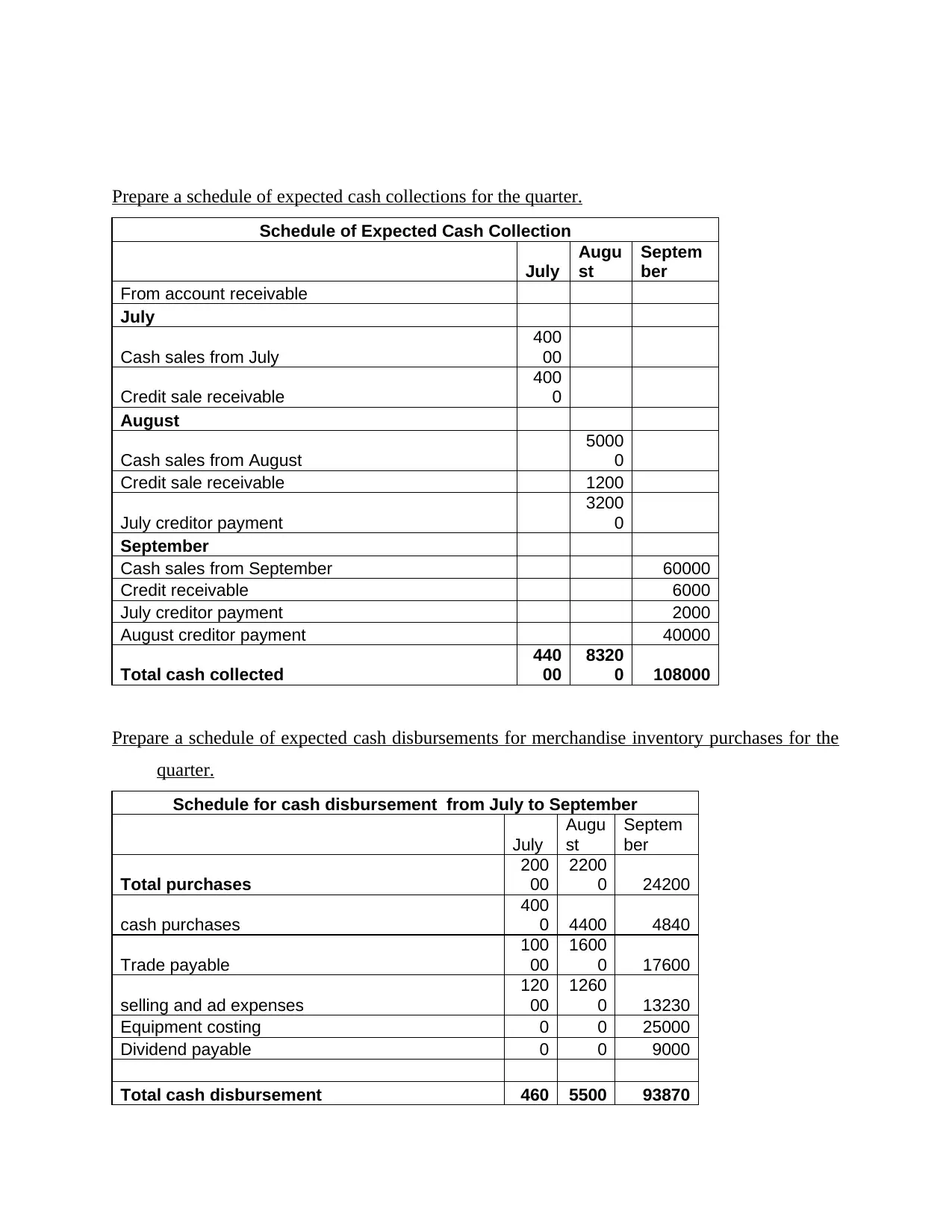
Prepare a schedule of expected cash collections for the quarter.
Schedule of Expected Cash Collection
July
Augu
st
Septem
ber
From account receivable
July
Cash sales from July
400
00
Credit sale receivable
400
0
August
Cash sales from August
5000
0
Credit sale receivable 1200
July creditor payment
3200
0
September
Cash sales from September 60000
Credit receivable 6000
July creditor payment 2000
August creditor payment 40000
Total cash collected
440
00
8320
0 108000
Prepare a schedule of expected cash disbursements for merchandise inventory purchases for the
quarter.
Schedule for cash disbursement from July to September
July
Augu
st
Septem
ber
Total purchases
200
00
2200
0 24200
cash purchases
400
0 4400 4840
Trade payable
100
00
1600
0 17600
selling and ad expenses
120
00
1260
0 13230
Equipment costing 0 0 25000
Dividend payable 0 0 9000
Total cash disbursement 460 5500 93870
Schedule of Expected Cash Collection
July
Augu
st
Septem
ber
From account receivable
July
Cash sales from July
400
00
Credit sale receivable
400
0
August
Cash sales from August
5000
0
Credit sale receivable 1200
July creditor payment
3200
0
September
Cash sales from September 60000
Credit receivable 6000
July creditor payment 2000
August creditor payment 40000
Total cash collected
440
00
8320
0 108000
Prepare a schedule of expected cash disbursements for merchandise inventory purchases for the
quarter.
Schedule for cash disbursement from July to September
July
Augu
st
Septem
ber
Total purchases
200
00
2200
0 24200
cash purchases
400
0 4400 4840
Trade payable
100
00
1600
0 17600
selling and ad expenses
120
00
1260
0 13230
Equipment costing 0 0 25000
Dividend payable 0 0 9000
Total cash disbursement 460 5500 93870
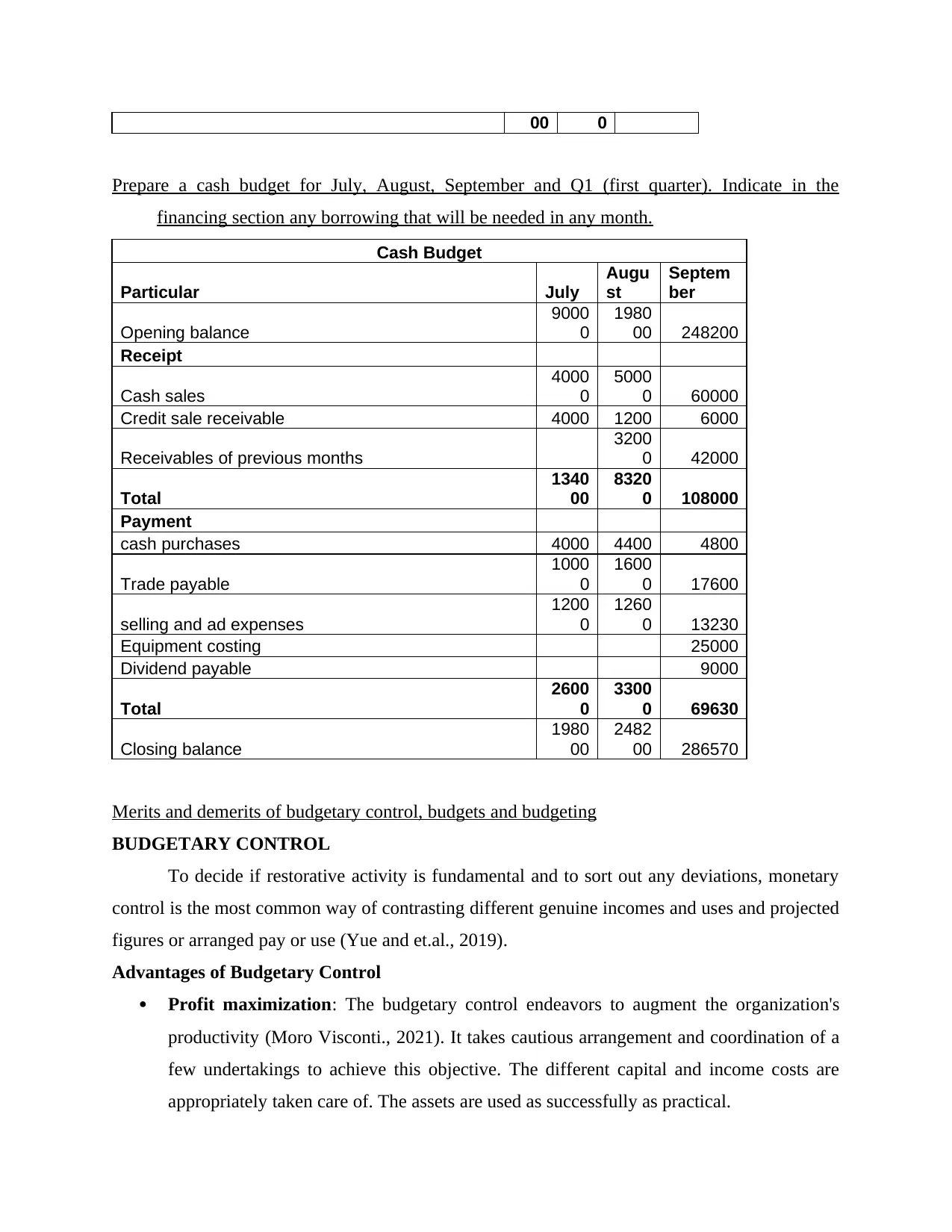
00 0
Prepare a cash budget for July, August, September and Q1 (first quarter). Indicate in the
financing section any borrowing that will be needed in any month.
Cash Budget
Particular July
Augu
st
Septem
ber
Opening balance
9000
0
1980
00 248200
Receipt
Cash sales
4000
0
5000
0 60000
Credit sale receivable 4000 1200 6000
Receivables of previous months
3200
0 42000
Total
1340
00
8320
0 108000
Payment
cash purchases 4000 4400 4800
Trade payable
1000
0
1600
0 17600
selling and ad expenses
1200
0
1260
0 13230
Equipment costing 25000
Dividend payable 9000
Total
2600
0
3300
0 69630
Closing balance
1980
00
2482
00 286570
Merits and demerits of budgetary control, budgets and budgeting
BUDGETARY CONTROL
To decide if restorative activity is fundamental and to sort out any deviations, monetary
control is the most common way of contrasting different genuine incomes and uses and projected
figures or arranged pay or use (Yue and et.al., 2019).
Advantages of Budgetary Control
Profit maximization: The budgetary control endeavors to augment the organization's
productivity (Moro Visconti., 2021). It takes cautious arrangement and coordination of a
few undertakings to achieve this objective. The different capital and income costs are
appropriately taken care of. The assets are used as successfully as practical.
Prepare a cash budget for July, August, September and Q1 (first quarter). Indicate in the
financing section any borrowing that will be needed in any month.
Cash Budget
Particular July
Augu
st
Septem
ber
Opening balance
9000
0
1980
00 248200
Receipt
Cash sales
4000
0
5000
0 60000
Credit sale receivable 4000 1200 6000
Receivables of previous months
3200
0 42000
Total
1340
00
8320
0 108000
Payment
cash purchases 4000 4400 4800
Trade payable
1000
0
1600
0 17600
selling and ad expenses
1200
0
1260
0 13230
Equipment costing 25000
Dividend payable 9000
Total
2600
0
3300
0 69630
Closing balance
1980
00
2482
00 286570
Merits and demerits of budgetary control, budgets and budgeting
BUDGETARY CONTROL
To decide if restorative activity is fundamental and to sort out any deviations, monetary
control is the most common way of contrasting different genuine incomes and uses and projected
figures or arranged pay or use (Yue and et.al., 2019).
Advantages of Budgetary Control
Profit maximization: The budgetary control endeavors to augment the organization's
productivity (Moro Visconti., 2021). It takes cautious arrangement and coordination of a
few undertakings to achieve this objective. The different capital and income costs are
appropriately taken care of. The assets are used as successfully as practical.
⊘ This is a preview!⊘
Do you want full access?
Subscribe today to unlock all pages.

Trusted by 1+ million students worldwide
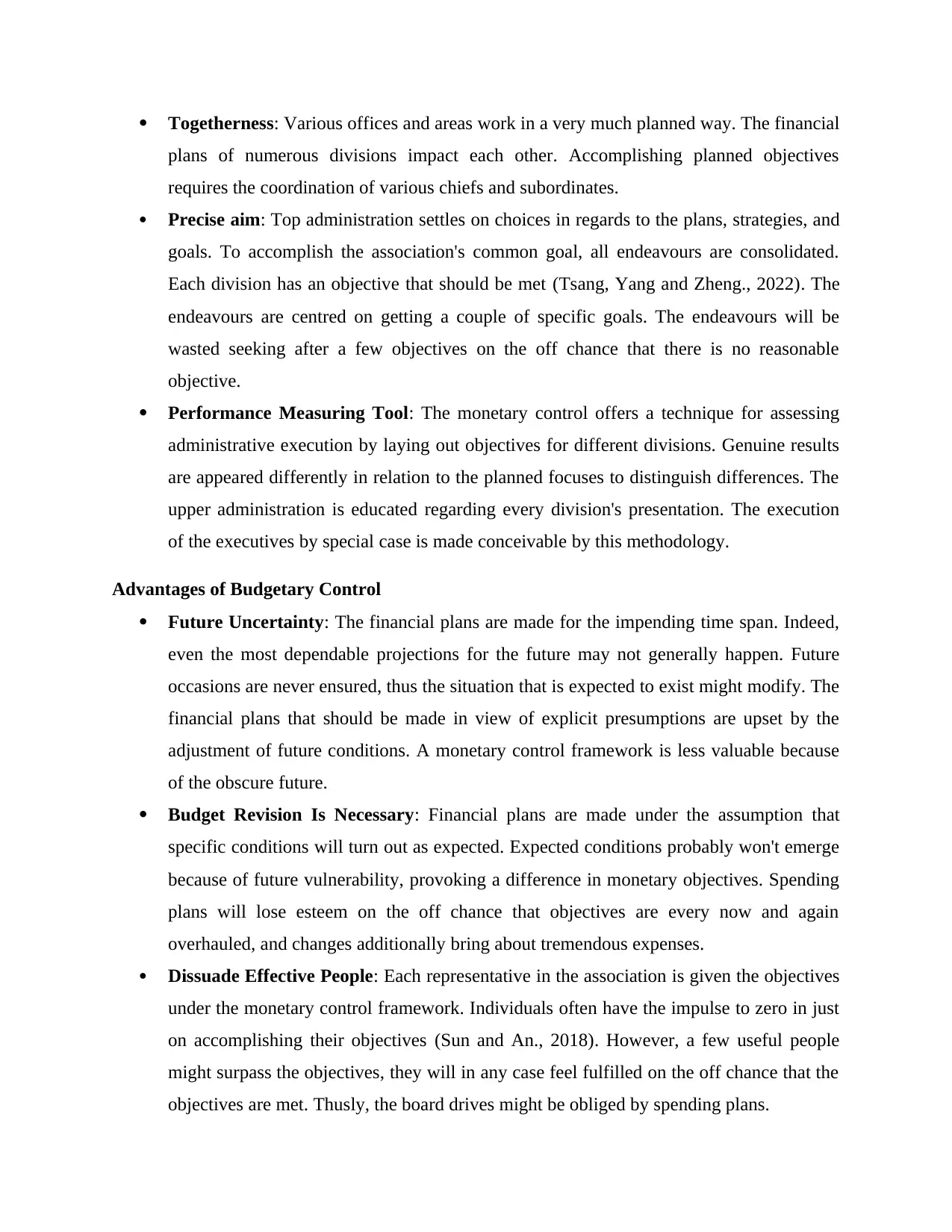
Togetherness: Various offices and areas work in a very much planned way. The financial
plans of numerous divisions impact each other. Accomplishing planned objectives
requires the coordination of various chiefs and subordinates.
Precise aim: Top administration settles on choices in regards to the plans, strategies, and
goals. To accomplish the association's common goal, all endeavours are consolidated.
Each division has an objective that should be met (Tsang, Yang and Zheng., 2022). The
endeavours are centred on getting a couple of specific goals. The endeavours will be
wasted seeking after a few objectives on the off chance that there is no reasonable
objective.
Performance Measuring Tool: The monetary control offers a technique for assessing
administrative execution by laying out objectives for different divisions. Genuine results
are appeared differently in relation to the planned focuses to distinguish differences. The
upper administration is educated regarding every division's presentation. The execution
of the executives by special case is made conceivable by this methodology.
Advantages of Budgetary Control
Future Uncertainty: The financial plans are made for the impending time span. Indeed,
even the most dependable projections for the future may not generally happen. Future
occasions are never ensured, thus the situation that is expected to exist might modify. The
financial plans that should be made in view of explicit presumptions are upset by the
adjustment of future conditions. A monetary control framework is less valuable because
of the obscure future.
Budget Revision Is Necessary: Financial plans are made under the assumption that
specific conditions will turn out as expected. Expected conditions probably won't emerge
because of future vulnerability, provoking a difference in monetary objectives. Spending
plans will lose esteem on the off chance that objectives are every now and again
overhauled, and changes additionally bring about tremendous expenses.
Dissuade Effective People: Each representative in the association is given the objectives
under the monetary control framework. Individuals often have the impulse to zero in just
on accomplishing their objectives (Sun and An., 2018). However, a few useful people
might surpass the objectives, they will in any case feel fulfilled on the off chance that the
objectives are met. Thusly, the board drives might be obliged by spending plans.
plans of numerous divisions impact each other. Accomplishing planned objectives
requires the coordination of various chiefs and subordinates.
Precise aim: Top administration settles on choices in regards to the plans, strategies, and
goals. To accomplish the association's common goal, all endeavours are consolidated.
Each division has an objective that should be met (Tsang, Yang and Zheng., 2022). The
endeavours are centred on getting a couple of specific goals. The endeavours will be
wasted seeking after a few objectives on the off chance that there is no reasonable
objective.
Performance Measuring Tool: The monetary control offers a technique for assessing
administrative execution by laying out objectives for different divisions. Genuine results
are appeared differently in relation to the planned focuses to distinguish differences. The
upper administration is educated regarding every division's presentation. The execution
of the executives by special case is made conceivable by this methodology.
Advantages of Budgetary Control
Future Uncertainty: The financial plans are made for the impending time span. Indeed,
even the most dependable projections for the future may not generally happen. Future
occasions are never ensured, thus the situation that is expected to exist might modify. The
financial plans that should be made in view of explicit presumptions are upset by the
adjustment of future conditions. A monetary control framework is less valuable because
of the obscure future.
Budget Revision Is Necessary: Financial plans are made under the assumption that
specific conditions will turn out as expected. Expected conditions probably won't emerge
because of future vulnerability, provoking a difference in monetary objectives. Spending
plans will lose esteem on the off chance that objectives are every now and again
overhauled, and changes additionally bring about tremendous expenses.
Dissuade Effective People: Each representative in the association is given the objectives
under the monetary control framework. Individuals often have the impulse to zero in just
on accomplishing their objectives (Sun and An., 2018). However, a few useful people
might surpass the objectives, they will in any case feel fulfilled on the off chance that the
objectives are met. Thusly, the board drives might be obliged by spending plans.
Paraphrase This Document
Need a fresh take? Get an instant paraphrase of this document with our AI Paraphraser
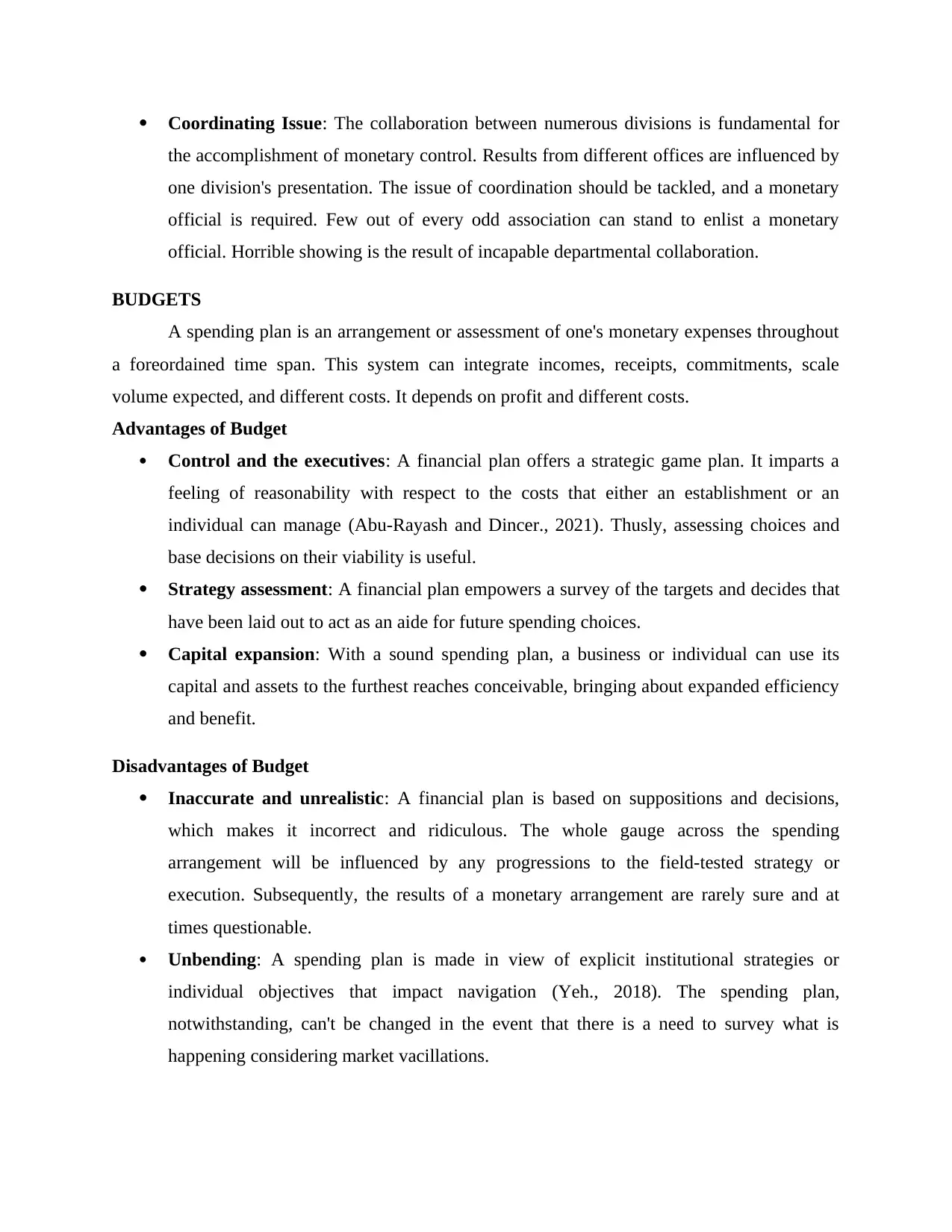
Coordinating Issue: The collaboration between numerous divisions is fundamental for
the accomplishment of monetary control. Results from different offices are influenced by
one division's presentation. The issue of coordination should be tackled, and a monetary
official is required. Few out of every odd association can stand to enlist a monetary
official. Horrible showing is the result of incapable departmental collaboration.
BUDGETS
A spending plan is an arrangement or assessment of one's monetary expenses throughout
a foreordained time span. This system can integrate incomes, receipts, commitments, scale
volume expected, and different costs. It depends on profit and different costs.
Advantages of Budget
Control and the executives: A financial plan offers a strategic game plan. It imparts a
feeling of reasonability with respect to the costs that either an establishment or an
individual can manage (Abu-Rayash and Dincer., 2021). Thusly, assessing choices and
base decisions on their viability is useful.
Strategy assessment: A financial plan empowers a survey of the targets and decides that
have been laid out to act as an aide for future spending choices.
Capital expansion: With a sound spending plan, a business or individual can use its
capital and assets to the furthest reaches conceivable, bringing about expanded efficiency
and benefit.
Disadvantages of Budget
Inaccurate and unrealistic: A financial plan is based on suppositions and decisions,
which makes it incorrect and ridiculous. The whole gauge across the spending
arrangement will be influenced by any progressions to the field-tested strategy or
execution. Subsequently, the results of a monetary arrangement are rarely sure and at
times questionable.
Unbending: A spending plan is made in view of explicit institutional strategies or
individual objectives that impact navigation (Yeh., 2018). The spending plan,
notwithstanding, can't be changed in the event that there is a need to survey what is
happening considering market vacillations.
the accomplishment of monetary control. Results from different offices are influenced by
one division's presentation. The issue of coordination should be tackled, and a monetary
official is required. Few out of every odd association can stand to enlist a monetary
official. Horrible showing is the result of incapable departmental collaboration.
BUDGETS
A spending plan is an arrangement or assessment of one's monetary expenses throughout
a foreordained time span. This system can integrate incomes, receipts, commitments, scale
volume expected, and different costs. It depends on profit and different costs.
Advantages of Budget
Control and the executives: A financial plan offers a strategic game plan. It imparts a
feeling of reasonability with respect to the costs that either an establishment or an
individual can manage (Abu-Rayash and Dincer., 2021). Thusly, assessing choices and
base decisions on their viability is useful.
Strategy assessment: A financial plan empowers a survey of the targets and decides that
have been laid out to act as an aide for future spending choices.
Capital expansion: With a sound spending plan, a business or individual can use its
capital and assets to the furthest reaches conceivable, bringing about expanded efficiency
and benefit.
Disadvantages of Budget
Inaccurate and unrealistic: A financial plan is based on suppositions and decisions,
which makes it incorrect and ridiculous. The whole gauge across the spending
arrangement will be influenced by any progressions to the field-tested strategy or
execution. Subsequently, the results of a monetary arrangement are rarely sure and at
times questionable.
Unbending: A spending plan is made in view of explicit institutional strategies or
individual objectives that impact navigation (Yeh., 2018). The spending plan,
notwithstanding, can't be changed in the event that there is a need to survey what is
happening considering market vacillations.
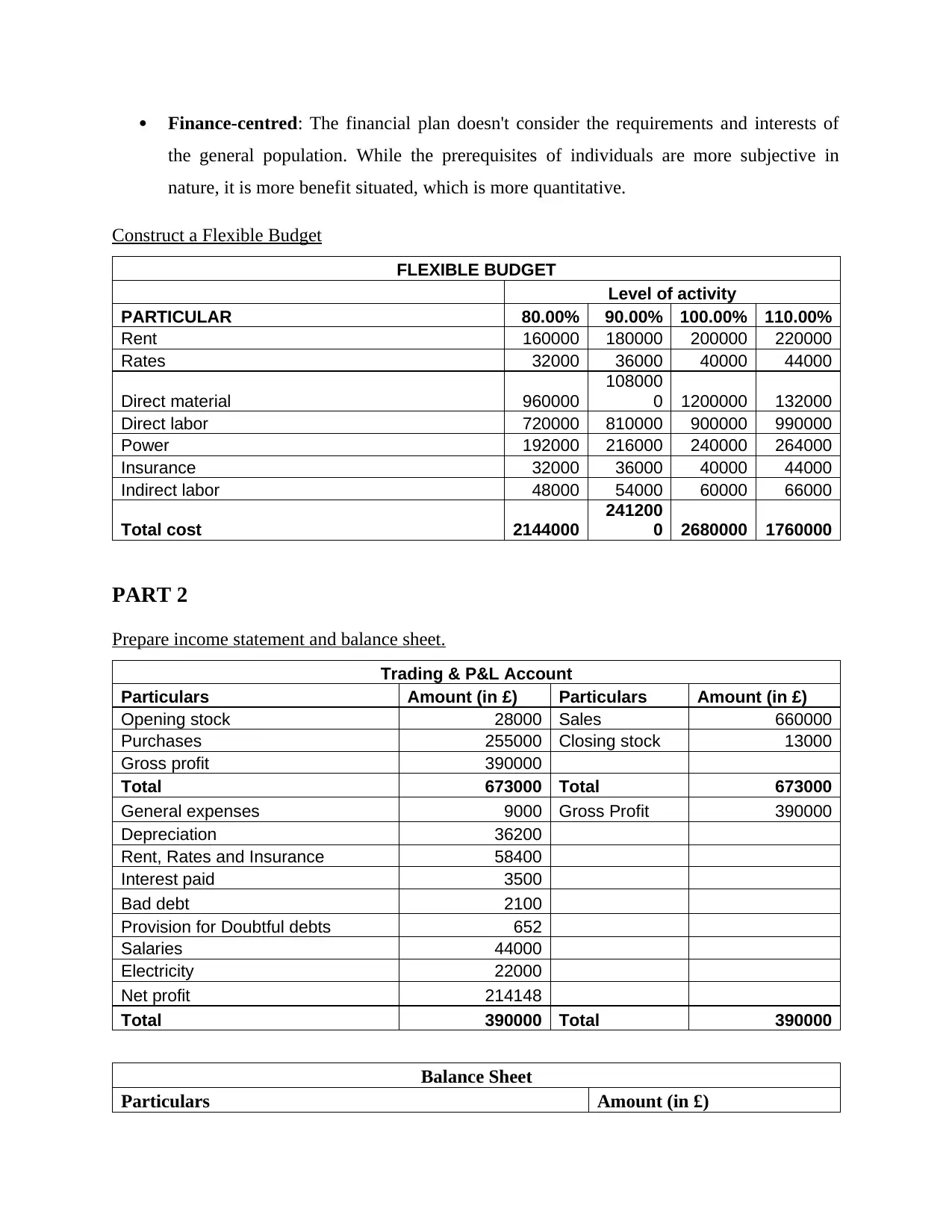
Finance-centred: The financial plan doesn't consider the requirements and interests of
the general population. While the prerequisites of individuals are more subjective in
nature, it is more benefit situated, which is more quantitative.
Construct a Flexible Budget
FLEXIBLE BUDGET
Level of activity
PARTICULAR 80.00% 90.00% 100.00% 110.00%
Rent 160000 180000 200000 220000
Rates 32000 36000 40000 44000
Direct material 960000
108000
0 1200000 132000
Direct labor 720000 810000 900000 990000
Power 192000 216000 240000 264000
Insurance 32000 36000 40000 44000
Indirect labor 48000 54000 60000 66000
Total cost 2144000
241200
0 2680000 1760000
PART 2
Prepare income statement and balance sheet.
Trading & P&L Account
Particulars Amount (in £) Particulars Amount (in £)
Opening stock 28000 Sales 660000
Purchases 255000 Closing stock 13000
Gross profit 390000
Total 673000 Total 673000
General expenses 9000 Gross Profit 390000
Depreciation 36200
Rent, Rates and Insurance 58400
Interest paid 3500
Bad debt 2100
Provision for Doubtful debts 652
Salaries 44000
Electricity 22000
Net profit 214148
Total 390000 Total 390000
Balance Sheet
Particulars Amount (in £)
the general population. While the prerequisites of individuals are more subjective in
nature, it is more benefit situated, which is more quantitative.
Construct a Flexible Budget
FLEXIBLE BUDGET
Level of activity
PARTICULAR 80.00% 90.00% 100.00% 110.00%
Rent 160000 180000 200000 220000
Rates 32000 36000 40000 44000
Direct material 960000
108000
0 1200000 132000
Direct labor 720000 810000 900000 990000
Power 192000 216000 240000 264000
Insurance 32000 36000 40000 44000
Indirect labor 48000 54000 60000 66000
Total cost 2144000
241200
0 2680000 1760000
PART 2
Prepare income statement and balance sheet.
Trading & P&L Account
Particulars Amount (in £) Particulars Amount (in £)
Opening stock 28000 Sales 660000
Purchases 255000 Closing stock 13000
Gross profit 390000
Total 673000 Total 673000
General expenses 9000 Gross Profit 390000
Depreciation 36200
Rent, Rates and Insurance 58400
Interest paid 3500
Bad debt 2100
Provision for Doubtful debts 652
Salaries 44000
Electricity 22000
Net profit 214148
Total 390000 Total 390000
Balance Sheet
Particulars Amount (in £)
⊘ This is a preview!⊘
Do you want full access?
Subscribe today to unlock all pages.

Trusted by 1+ million students worldwide
1 out of 17
Related Documents
Your All-in-One AI-Powered Toolkit for Academic Success.
+13062052269
info@desklib.com
Available 24*7 on WhatsApp / Email
![[object Object]](/_next/static/media/star-bottom.7253800d.svg)
Unlock your academic potential
Copyright © 2020–2025 A2Z Services. All Rights Reserved. Developed and managed by ZUCOL.




